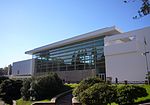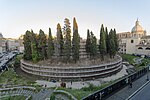San Rocco, Rome
16th-century Roman Catholic church buildings in Italy19th-century Roman Catholic church buildings in ItalyChurches of Rome (rione Campo Marzio)Roman Catholic churches in Rome

San Rocco is a church at 1 Largo San Rocco, Rome, dedicated to Saint Roch. It is next to the Mausoleum of Augustus. The Confraternita di San Rocco has charge of the church; it is part of the Parish of Saint Giacomo.
Excerpt from the Wikipedia article San Rocco, Rome (License: CC BY-SA 3.0, Authors, Images).San Rocco, Rome
Piazza Augusto Imperatore, Rome Municipio Roma I
Geographical coordinates (GPS) Address External links Nearby Places Show on map
Geographical coordinates (GPS)
| Latitude | Longitude |
|---|---|
| N 41.905458333333 ° | E 12.4759 ° |
Address
San Rocco all'Augusteo
Piazza Augusto Imperatore 6
00186 Rome, Municipio Roma I
Lazio, Italy
Open on Google Maps











